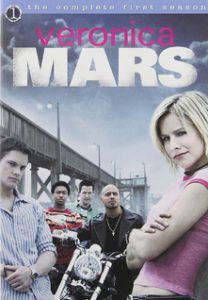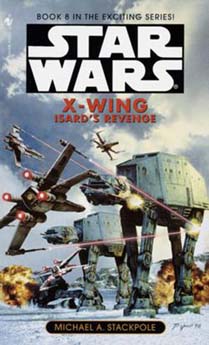“Isard’s Revenge,” the eighth book in the “X-Wing” series (and Michael Stackpole’s last), came out in April 1999, one month before “The Phantom Menace.” Overshadowed by that film then and now, “Isard’s Revenge” didn’t have anything so epic as the backstory of Anakin Skywalker. Still, it did fill in a crucial gap in “Star Wars” lore — sort of — and answer some lingering questions.
The book opens during the final space battle of Timothy Zahn’s “The Last Command,” as Thrawn is being defeated once and for all. However, it doesn’t go all the way up to the start of “Dark Empire” — one year after the Thrawn trilogy — when various Imperial factions are fighting over Coruscant, from which the New Republic has been banished. (One important plot hole is filled in, at least, as Jan Dodonna is rescued from a decade of Imperial imprisonment, allowing him to regain his generalship for “Dark Empire.”) I suppose it’d be hard to fit another “X-Wing” novel in there to tell the “Fall of Coruscant” story. But maybe a “TIE Fighter” yarn would work; after all, that title did spin off from the “X-Wing” video game.
In somewhat too pulpy of a fashion, Stackpole brings back Isard — twice! Not only did Isard survive Corran blowing up her supposed escape shuttle at the end of “The Bacta War,” but there’s also an Isard clone out there. It’s remarkable how casually “Star Wars” authors pepper clones into their work, and this might be one of the most unnecessary uses of a clone. The clone could’ve been used to explain away Isard’s change in behavior and strategy in “The Bacta War,” but ultimately, that’s not what Stackpole does — we learn that that was indeed Isard back on Thyferra. And the clone is so underdeveloped that one wonders what the point of including her was.
Still, it’s not like the Isard clone derails the narrative too much. All of the good guys are in fine form. By this point in the narrative, I realize that I really dig de facto main character Corran Horn, along with his loving relationship with his wife, Mirax, and his droid, Whistler. Whistler and Wedge’s astromech, Gate, get a whole starring chapter here. (And, indeed, one chapter is about the right length for droid heroics; too bad “The Clone Wars’ ” four-episode “droids in the void” arc didn’t adhere to that rule of brevity.)
One of Stackpole’s strengths is writing the “pilots reflect on death” scenes, and he pens a great one when Corran talks to Gavin after the death of his lover, the Bothan Asyr. Some pilot deaths have more impact than others, though, and I have to give the author credit for a jaw-dropper (as in, my jaw literally dropped as I read it) during a battle postmortem on page 189: “Khe-Jeen Slee had been the first to die, followed by Lyyr Zatoq and then Wes Janson.”

The way he casually dispatches the best friend of Wedge — rather than describing his final battle in an epic fashion (as with, say, Chewbacca’s death in “Vector Prime”) — nicely underscores the random cruelty of war. Of course, I knew Janson would be coming back, as I remembered him being a main character in “Starfighters of Adumar,” and that’s part of why I had forgotten his temporary death. Whether it’s a cheat or not to bring him back, it doesn’t much diminish the power of the words in the moment.
Out of all the books in the series, “Isard’s Revenge” might be the one that most rewards longtime “Star Wars” fans, as Stackpole not only taps into the Thrawn trilogy and “Dark Empire,” but also his own “X-Wing: Rogue Squadron” comic books. He brings the Quarren Lyyr Zatoq back into Rogue Squadron, has Zatoq reflect on events from those early days (the comics take place before any of the books), and returns the action to the planet Cuitric and its Imperial leader, Krennel (who is arguably more of a presence here than either of the Isards).
This turned out to be Stackpole’s last “X-Wing” novel, but rather than feeling like the whole story has been told, I feel like there’s more story to tell, and not just from the cockpit of a snubfighter (For example, what happens next with Asyr? Bothan politics are fascinating, and it’d be neat to see her navigate that — and maybe stick it to Fey’lya one more time.). I’m sure Dave Filoni and the gang will do a fine job with “Star Wars: Rebels,” but one potential problem with that TV series is that there are no obvious central characters, as there was with “The Clone Wars.” Maybe “X-Wing” — with its endless well of great characters — should’ve been a TV series; maybe it still can be somewhere down the road.

